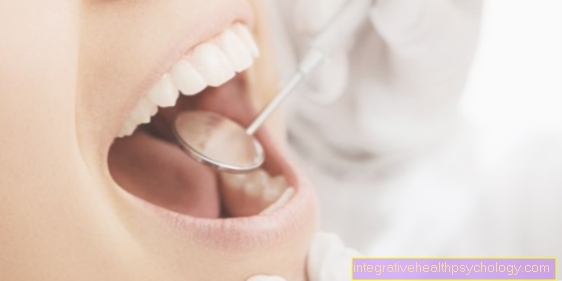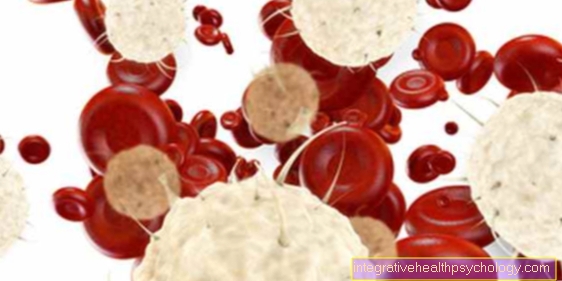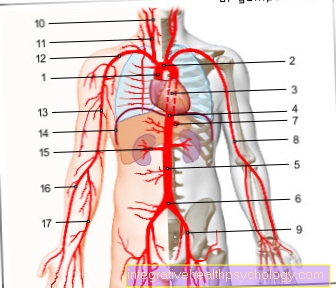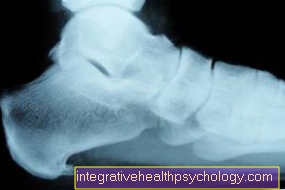Salivary glands
Synonyms
Spit, Saliva
Classification
Under the term "salivary glands" (Glandulae salivatoriae) are all those exocrine glands that produce saliva and secrete it into the oral cavity. (In the past, the pancreas was also counted among the salivary glands, a classification that has now been abandoned, which is why today we usually mean the mouth saliva when we speak of saliva.)
In humans, a distinction is made between large and small salivary glands. There are three large salivary glands, which are organs of their own and which have a fixed boundary: The parotid gland (Parotid gland), the mandibular salivary gland (Submandibular gland) and the sublingual salivary gland (Sublingual gland). Together, they are responsible for around 90% of the saliva produced. The remaining 10% is formed by the small salivary glands (lip glands, cheek glands, tongue glands, palate glands, molar glands), which are scattered almost everywhere in the submucosa of the oral mucosa.

Production and secretion
A distinction is made between two forms of saliva, on the one hand the serous Saliva that tends to thin to watery is and under the influence of the parasympathetic Part of the vegetative nervous system arises, and the mucous (mucinous) saliva, which is more likely slimy to viscous is and under sympathetic Influence is produced.
The Parotid gland is pure serous, so it only releases thin saliva. The other two major salivary glands are mixed glands, being the mandibular salivary gland sero-mucous is, i.e. mainly consists of areas that secrete serous saliva, whereas the sublingual gland as muco-serous is called because it has more end pieces that produce the mucous saliva.
All ducts of the large salivary glands ultimately open into the oral cavity (the sublingual and mandibular salivary glands have a common duct, the end of which is under the tongue; the duct of the parotid gland opens into the mucous membrane opposite the 1. Upper molar), which is why a mixture of the different types of saliva can be found there.
Through the production of saliva, the salivary glands fulfill important functions in the context of digestion, defense and dental hygiene.
function
There are many salivary glands within the human body. These can assume a different function. The most important function of the salivary glands within the oral cavity is the production and secretion of a viscous to thin fluid secretion. This secretion serves, among other things, to moisten the oral cavity. In addition, one function of the salivary glands of the oral cavity is to keep the chyme moist and smooth while eating. In this way, the act of swallowing and the transport of food between the esophagus and the stomach entrance are facilitated.
The function of the salivary glands within the oral cavity also includes the production and secretion of some enzymes. The enzymes relevant in this context belong to the group of so-called "amylases". These enzymes have starch-splitting properties and for this reason enable digestion to begin, which already begins within the oral cavity.
In addition, there is a crucial function of the salivary glands, or saliva, as Acid-base buffer to act within the oral cavity. The normal pH value of the oral cavity can be shifted by eating various foods. Normally the pH in the oral cavity should be around 7 (neutral area). If the pH drops, demineralization processes can already occur on the surface of the tooth roots at a value of around 6.7. From a pH value of around 5.5, tooth enamel can also be irreversibly damaged. Increased pH can also have a negative impact on oral health.
In this context, the salivary glands have the function of adapting the production of saliva to the ambient conditions. This is done by controlling the viscosity of the secretion. In order to be able to effectively buffer, the released saliva can have a higher or lower fluid and / or protein content.
Ultimately, the saliva secreted by the salivary glands also has a cleansing function. Particularly thin secretions can wash around the individual teeth and in this way remove food residues.
Salivary gland diseases
A variety of diseases can occur in the area of the salivary glands.
- Tumors: A distinction is made between tumors of the salivary glands in benign (adenomas) and malignant (adenocarcinomas) neoplasms. About 80% of these changes affect the parotid gland. The most common tumor of the salivary glands is the so-called pleomorphic adenoma, which is a mixed tumor that occurs primarily in women. Although it is primarily benign, it is usually removed early to prevent degeneration. After the operation, however, there are recurrences in about 10% of patients. Malignant tumors often develop under the influence of radiation and usually require a generous removal of glandular tissue, which is usually not without risk, as the important facial nerve, for example, runs through the parotid gland, which runs a very high risk of being injured during an operation.
- Salivary stones: In the ducts of the salivary gland, salivary stones (Sialolithiasis) come. The mandibular salivary gland is most frequently affected, with about 80%. Stones are usually caused by an incorrect composition of the saliva (Dyschyly), their main component is usually calcium phosphate and they are not uncommon. In most cases, salivary stones can be operated on relatively easily or, more recently, also crushed with the help of ultrasonic shock waves, whereupon the body can remove the small fragments itself. A prolonged existence of salivary stones promotes the occurrence of a salivary gland inflammation via a secondary colonization with germs (Sialadenitis).
- Salivary gland inflammation: By far the most relevant for everyday medical practice (but fortunately not too common nowadays because of the vaccination that has been introduced) is the parotid gland inflammation, which is triggered by the mumps virus. In this disease, the affected salivary gland swells up and becomes painful. A dreaded complication here is the tearing of the duct, which leads to the leakage of saliva into the adjacent tissue and can lead to the formation of a salivary cyst. In most cases, however, the parotid gland heals on its own without permanent damage. More dangerous in the context of mumps are the complications that can take place outside the parotid gland, namely the spreading to the testicles, which causes a very painful inflammation here (Orchitis) or even brain involvement that leads to encephalitis.
- Autoimmune diseases: In the autoimmunological disease S jögren's syndrome, various glands of the face are restricted in their secretion production, which is why dry mouth, dry eyes (possibly with conjunctivitis) and lacrimal gland inflammation occur. Classically, the parotid gland initially swells in those affected before it finally decreases significantly in size (atrophy). It is assumed that this syndrome is based on the presence of autoantibodies that are directed against the duct epithelium of the glands. In addition to the symptoms mentioned above, joint inflammation is also common in patients (Polyarthritis) and pain. This disease is usually diagnosed by taking tissue (biopsy) from the oral cavity.
- Swelling: Swelling of the salivary glands can also have non-inflammatory causes. These include the side effects of some drugs (e.g. beta blockers), metabolic disorders such as hyperthyroidism (Hyperthyroidism) or diabetes mellitus or alcohol abuse.
Inflammation of the salivary glands
The inflammation of the salivary gland is one of the most common diseases that occur in the enriched salivary glands. In general are above all elderly and / or immunocompromised people affected by inflammatory processes in the area of the salivary glands.
The causes that lead to the development of a salivary gland inflammation can vary. In most of the cases this disorder lies bacterial or viral pathogens underlying the about the Oral cavity ascend into the salivary glands. In the case of bacterial genesis mainly play Staphylococci and Streptococci a crucial role. The most common viral pathogens causing inflammation of the salivary glands include Coxsacki- and mumps-Viruses.
Also include smallest stones which get stuck in the ducts of the salivary glands are the most common causes of salivary gland inflammation. In the course of this relocation it comes to Back pressure of the secretary of the salivary glands and to the accumulation of large quantities of this secretion within the glands. The secretion ultimately forms the ideal breeding ground within the salivary glands for bacterial pathogens that cause salivary gland inflammation.
Furthermore you can Swelling and Tumors Curb the normal outflow of secretions and lead to an inflammation of the salivary glands via the same mechanism.
In addition to these causes for the development of inflammatory processes within the salivary glands can also be various Autoimmune diseases lead to problems. A classic example of such an autoimmune disease is cystic fibrosis (Cystic fibrosis). In the course of this disease, there is a loss of special functions Chloride channels and an associated thickening of the saliva.
In addition, various underlying diseases and behaviors can increase the risk of inflammatory processes developing within the salivary glands. The underlying diseases and behaviors relevant in this context include:
- Diabetes mellitus
- gout
- Excess of calcium ions
- Tobacco use
- Alcohol consumption
As a rule, inflammation of the salivary glands occurs strictly on one side of one of the two large salivary glands.
In the affected patients there is a sudden development of symptoms with strong Swelling and Pain. Typically, most of those affected observe the onset of symptoms during or immediately after eating. Furthermore, the inflammatory processes within one of the salivary glands lead to a Restriction of the mouth opening.
If the salivary gland inflammation is severe, general symptoms may also be present fever, chills and a headache occur.
The Treatment of inflammation of the salivary glands depends on the causal disease. Little ones Salivary stones can often through a Stimulation of saliva production and performing juices massages are resolved. Bacterial infections usually need one antibiotic treatment. In the case of vitally induced salivary gland inflammation, only symptomatic therapy can be used.
Salivary gland stone
The Formation of a stone of the salivary gland can have serious consequences. For example, a small stone can be flushed out of the salivary gland and get stuck in its ducts. As a result, there is a Blockage of the usual secretion passage. The released saliva builds up and begins to occupy the gland. This provides the ideal breeding ground for bacterial pathogens which settle in the salivary glands, multiply and inflammatory processes cause.
The formation of a stone of the salivary gland can various causes to have. Especially one Limitation of saliva production in a row one pronounced lack of fluids plays a crucial role in this context.
A stone that is stuck in the duct of the salivary glands does not always have to lead to discomfort. Especially in the case of a very small stone, the gland secretion can often flow past the stone. As a rule, however, the constant passage of saliva leads to one within a certain period of time enormous increase in size of the salivary stone. In the course of time, the increasingly larger stone begins to completely block the execution passage and one Inflammation of the salivary glands to provoke. Patients with inflammation of the salivary gland caused by a stone usually develop sudden onset of pain. In addition, it comes to visible swelling in the area of the affected salivary glands.
A treatment Salivary gland inflammation can only be successful if the causative stone is removed from the duct of the salivary glands. For many of the affected patients, this is about one Stimulation of saliva production possible. Affected patients are advised to drink sufficient amounts of fluids. The increasing rate of saliva secretion can lead to the stone being washed out of the duct of the salivary glands. They can also be prudent Salivary gland massages help flush out a stone.
If these measures do not achieve the goal, another treatment method must be initiated as soon as possible. Even a stone that cannot be felt from the outside can often not be treated by increasing the rate of saliva secretion and requires the introduction of other treatment methods.
One of the most important measures in the therapy of stones in salivary glands is the so-called "extracorporeal shock wave lithotripsy". With this method of treatment, from the outside Sound waves aimed at the stone and tries to split it into smaller fragments. The fragments of the stone (Concrements) are flushed out through the regular flow of saliva.
Patients who suffer from many and / or frequently recurring stones in the salivary gland may have the surgical removal of the affected salivary glands be useful.
Obstruction of the salivary glands
To a Obstruction of the salivary glands it can happen for different reasons. The main cause of obstruction of the salivary glands is the Formation of salivary stones In addition, you can severe swelling lead to a blockage of the salivary glands within the salivary glands and / or in the surrounding tissue.
Some patients develop one through the making of one Ulcer caused obstruction of the salivary glands. These ulcers can be both benign, as well as vicious be (Tumors).
Ultimately, regardless of the underlying disease, causes the Backwater of the discharged secretion the actual constipation. Because of this, the typical symptoms of a blockage of the salivary glands occur in most of the cases during or shortly after eating on. The classic symptoms that indicate a blockage of the salivary glands include local swelling and Pain. In addition, depending on which of the salivary glands has a blockage, it can lead to one Impairment of the mouth opening come. Patients who suffer from the classic symptoms should get one as soon as possible Specialist and have the underlying problem clarified. In this way, complications and / or consequential damage can be prevented in most cases. The treatment is ultimately always based on the underlying disease.





























